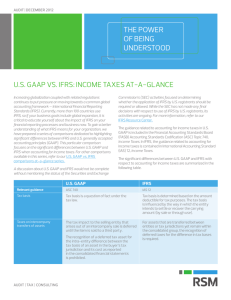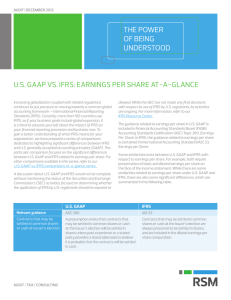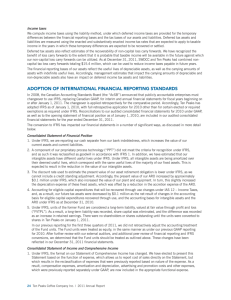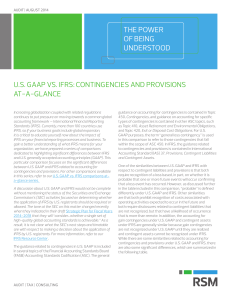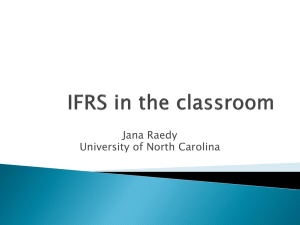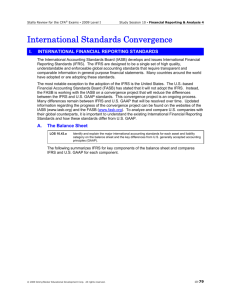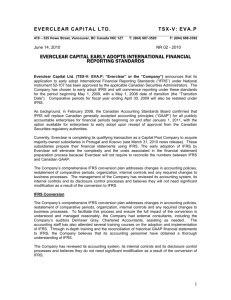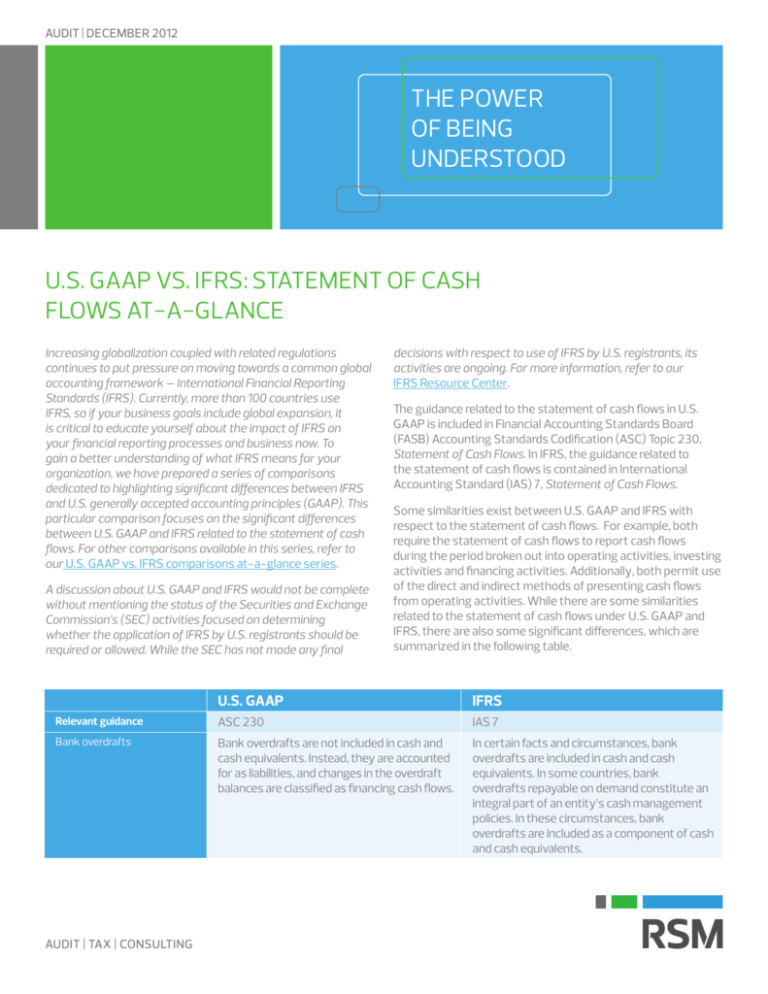
AUDIT | DECEMBER 2012
THE POWER
OF BEING
UNDERSTOOD
U.S. GAAP VS. IFRS: STATEMENT OF CASH
FLOWS AT-A-GLANCE
Increasing globalization coupled with related regulations
continues to put pressure on moving towards a common global
accounting framework – International Financial Reporting
Standards (IFRS). Currently, more than 100 countries use
IFRS, so if your business goals include global expansion, it
is critical to educate yourself about the impact of IFRS on
your financial reporting processes and business now. To
gain a better understanding of what IFRS means for your
organization, we have prepared a series of comparisons
dedicated to highlighting significant differences between IFRS
and U.S. generally accepted accounting principles (GAAP). This
particular comparison focuses on the significant differences
between U.S. GAAP and IFRS related to the statement of cash
flows. For other comparisons available in this series, refer to
our U.S. GAAP vs. IFRS comparisons at-a-glance series.
A discussion about U.S. GAAP and IFRS would not be complete
without mentioning the status of the Securities and Exchange
Commission’s (SEC) activities focused on determining
whether the application of IFRS by U.S. registrants should be
required or allowed. While the SEC has not made any final
decisions with respect to use of IFRS by U.S. registrants, its
activities are ongoing. For more information, refer to our
IFRS Resource Center.
The guidance related to the statement of cash flows in U.S.
GAAP is included in Financial Accounting Standards Board
(FASB) Accounting Standards Codification (ASC) Topic 230,
Statement of Cash Flows. In IFRS, the guidance related to
the statement of cash flows is contained in International
Accounting Standard (IAS) 7, Statement of Cash Flows.
Some similarities exist between U.S. GAAP and IFRS with
respect to the statement of cash flows. For example, both
require the statement of cash flows to report cash flows
during the period broken out into operating activities, investing
activities and financing activities. Additionally, both permit use
of the direct and indirect methods of presenting cash flows
from operating activities. While there are some similarities
related to the statement of cash flows under U.S. GAAP and
IFRS, there are also some significant differences, which are
summarized in the following table.
U.S. GAAP
IFRS
Relevant guidance
ASC 230
IAS 7
Bank overdrafts
Bank overdrafts are not included in cash and
cash equivalents. Instead, they are accounted
for as liabilities, and changes in the overdraft
balances are classified as financing cash flows.
In certain facts and circumstances, bank
overdrafts are included in cash and cash
equivalents. In some countries, bank
overdrafts repayable on demand constitute an
integral part of an entity’s cash management
policies. In these circumstances, bank
overdrafts are included as a component of cash
and cash equivalents.
AUDIT | TAX | CONSULTING
Classification of interest
and dividends
U.S. GAAP
IFRS
Interest received or paid is classified as
operating activities.
Cash flows from interest and dividends
received or paid should be classified in a
consistent manner as either operating,
investing or financing activities.
Dividends received are classified as
operating activities.
Dividends paid are classified as
financing activities.
Interest paid and interest and dividends
received are usually classified as operating
cash flows for a financial institution.
Alternatives for other entities include the
following: (a) interest and dividends paid
may be classified as operating or financing
cash flows and (b) interest and dividends
received may be classified as operating or
investment activities.
Interest payments capitalized under
IAS 23, Borrowing Costs, should be
classified in a manner consistent with the
underlying asset for which the interest
was capitalized.
These are the significant differences between U.S. GAAP and
IFRS related to the statement of cash flows. Refer to ASC
230 and IAS 7 for all of the specific requirements applicable
to the statement of cash flows. Refer to our U.S. GAAP vs.
IFRS comparisons at-a-glance series for more comparisons
highlighting other significant differences between U.S. GAAP
and IFRS.
Contact:
Richard Stuart, Partner
National Accounting Standards Group, RSM US LLP
+1 203 905 5027
richard.stuart@rsmus.com
+1 800 274 3978
www.rsmus.com
This document contains general information, may be based on authorities that are subject to change, and is not a substitute for professional advice or services. This document does not constitute audit, tax, consulting,
business, financial, investment, legal or other professional advice, and you should consult a qualified professional advisor before taking any action based on the information herein. RSM US LLP, its affiliates and related
entities are not responsible for any loss resulting from or relating to reliance on this document by any person. Internal Revenue Service rules require us to inform you that this communication may be deemed a solicitation
to provide tax services. This communication is being sent to individuals who have subscribed to receive it or who we believe would have an interest in the topics discussed. RSM US LLP is a limited liability partnership and
the U.S. member firm of RSM International, a global network of independent audit, tax and consulting firms. The member firms of RSM International collaborate to provide services to global clients, but are separate and
distinct legal entities that cannot obligate each other. Each member firm is responsible only for its own acts and omissions, and not those of any other party. Visit rsmus.com/aboutus for more information regarding
RSM US LLP and RSM International. RSM® and the RSM logo are registered trademarks of RSM International Association. The power of being understood® is a registered trademark of RSM US LLP.
© 2015 RSM US LLP. All Rights Reserved.
is_as_0915_ifrs cash flow statements at a glance

